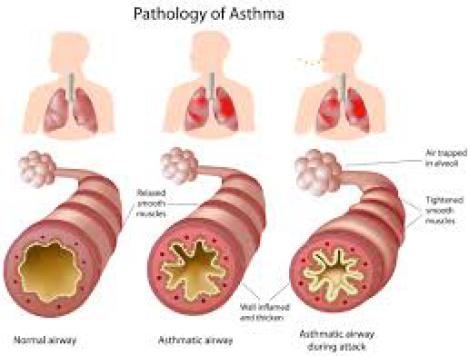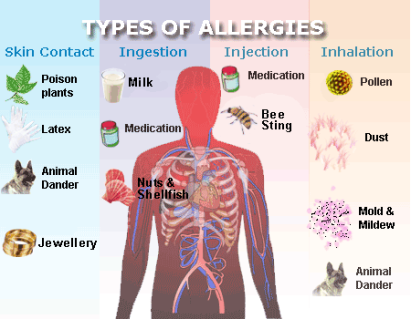May Blog
MAY BLOG
ASTHMA AND ALLERGY AWARENESS
The Prevalence of Asthma and Asthma Attacks
People who suffer from asthma and allergies experience physical symptoms during the month of May! The prevalence of asthma has increased during the last few decades. Centers for Disease Control and Prevention reports, that Asthma affected 7.3% of the global population in 2001. 25 million people have asthma, 7 million are children. The prevalence of the condition was higher among American Indians, native Alaskans and Black Americans compared to Whites. The highest incidence of asthma emergencies, hospitalizations and death occurs in African Americans, but those of Puerto Rican decent are also disproportionally affected. Asthma UK reports that 5.4 million people in the United Kingdom are currently receiving treatment for asthma, which includes 4.3 million adult citizens and 1.1 million children. A review by the Seoul National University College of Medicine in Korea reports 11.9% of Asia’s population experience symptoms of asthma. Asthma Australia, reports approximately 11.11%, or 2.5 million individuals, have been diagnosed with asthma. Through education, it is hoped that people will take early action to deal with any symptoms.
Aspects of Asthma
To understand exactly how asthma works, the University of Illinois’s Hospital & Health Sciences System explains that the three major aspects that are involved in the disease include:
- Inflammation – the core problem, the walls of the airways are always inflamed and produce excessive amounts of mucus. The combination of inflammation and mucus results in a narrowing of the space that is available for air to travel which causes breathing problems.
- Airway Hyper-responsiveness – the airway is extremely sensitive to certain substances such as dust, the airway triggers a reaction due to its sensitivity, causing the muscles in the airway to squeeze. When this happens, several symptoms such as coughing and wheezing occur.
- Excessive Bronchoconstriction – the muscles in the airway quickly contracts, which results in a further restriction of space available for air to move in and out of the lungs. The smooth muscle tissue found in the airways of an asthmatic patient is usually stronger and much larger it is in a person without asthma.
Asthma Risk Factors
Experts have identified certain risk factors that contribute to the higher chance of developing the disease. The American Lung Association reports the following common risk factors contributing to being diagnosed as an asthmatic patient:
- Family History of Asthma – If the disease runs in the family, you will have a much higher risk of developing the disease by 600%.
- Exposures at The Workplace – People constantly exposed to certain substances at their workplace are more likely to experience asthmatic symptoms. Examples of potential substances that cause symptoms include molds, wood and industrial dust, as well as chemical vapors and fumes.
- Regions With High Levels of Air Pollution – There is a global epidemic regarding air pollution but some regions have much higher air pollution levels than others creating a higher risk of becoming asthmatic.
- Being Overweight Or Obese –The specific reasons why excess weight poses a risk factor for asthma are still unclear, but medical experts believe that because of the low-grade inflammation that occurring in the body when there is excess weight.
Signs and Symptoms of Asthma & Allergies
Asthma is a long-term condition which causes the airways that carry air into and out of the lungs to become swollen. When the airway swells up, excess mucus is produced. When the airways swell up, they become narrow, causing unpleasant symptoms. Severe asthma symptoms can begin with itching of the eyes and face, but can progress to swelling causing shortness of breath or breathing difficulties, tightness in the chest, coughing, wheezing, cramps, diarrhea and vomiting. Confusion and dizziness are other symptoms of asthma.
Environmental triggers include passive smoking, molds, cockroaches, pet hair and dust mites. Combined with medical treatment, these environmental triggers can be controlled allowing asthma sufferers to live active and healthy lives.
An allergy is defined as a harmful response of the immune system to substances that normally would be harmless instances. The allergic reaction can be mild as in the case of hay fever or severe as in the case of anaphylaxis. Anaphylaxis is a medical emergency, an allergic reaction that often leads to shock in addition to a skin rash, facial swelling, nausea, vomiting, diarrhea, and airway obstruction. Anaphylaxis is a Type I allergic reaction, and it occurs between 15 and 30 minutes upon exposure to an allergen. Allergies that could trigger anaphylaxis include food and medication.
Baroness Ilora Finlay, WAO White Book on Allergy: 2013 Update, “we’re currently witnessing a worldwide allergy epidemic affecting more than 20% of people in developed countries. It’s interesting to note that the prevalence of allergies varies between 1% and 40% between countries and affluence and lifestyle seem to play a big part in this discrepancy.”
The Hygiene Hypothesis
Researchers do not know why people develop allergies, but there are many proposed reasons or thoughts, the most controversial being the “hygiene
hypothesis.” The hygiene hypothesis indicates that a lack of early childhood exposure to pathogens and substances increases a person’s risk of
allergic disease by suppressing the normal development of the immune system.
The hypothesis was first established in 1989 by David Strachan, from the assumption that greater levels of hygiene practiced in developed countries means that children are not exposed to pathogens as children in less developed countries. Previous research found that our immune system is partially regulated by the reaction between pathogen and host, an example: being vaccinated is a result of injecting antigens into the body to stimulate the body to develop immunity against the injected pathogen. However, most allergy experts today believe that the hygiene hypothesis is too simple of an explanation for something as complex as allergic disease! An article published in the July 2016 issue of the Perspectives in Public Health explains that hygiene has nothing to do with allergy onset. Most theories suggest that our changing environment and lifestyle has a lot to do with the current rise in allergic disease which seems to be affecting children more so than adults.
Treatment includes avoiding the substance causing the allergic reaction, taking allergy medication and allergy shots. These treatments are successful in controlling allergies, but don’t cure the allergy. Allergies in adults are usually considered a chronic disease. Children have the unique ability to outgrow an allergy despite being the group with the highest allergy prevalence.
Strategies to Help Prevent Allergies In Children
Natural childbirth, breastfeeding, greater interaction between siblings and peers, increasing levels of physical activity and time spent outdoors, reducing time spent
indoors and reducing antibiotic intake, including that found in food, are just some ways to support the development of a strong and well-functioning immune system. Probiotics, organic food, and
generally balanced and healthy diets
may also help with the development of a healthy immune system and reduced risk of allergies in children.
There seem to be as many types of allergies, but to simplify things allergies are divided into the manner in which an allergen enters the body and 4 classifications that indicate the severity and cause. Be aware that people can be allergic to almost any substance including water, light, semen and sweat but these types of allergies are extremely rare. I can attest to how random an allergy can be. I am allergic to gold! I have also had severe reactions to medications to the extent of respiratory arrest and seizures! That is the main reason I stay the holistic and herbal course for remedies.
Manner of Allergen Intake:
- Inhalation - when a person breathes in an allergen such as pollen, dust, fungus spores, animal hairs, etc. Symptoms can be a runny nose, itchy eyes, sore throat, and wheezing. These allergies are usually a reaction to the protein molecule found in the allergen.
- Food allergies - when you eat a food that contains an allergen. Most common food allergies are nuts, seafood, fruit, wheat, cow’s milk, eggs and rice. These need to be distinguished from food intolerances which have different causes and symptoms.
- Medication - a type of medicine containing common allergen products. Aspirin and penicillin are two of the most common types of medicine that some people are allergic to.
- Insect bites and stings - Most reactions happen due to the venom being injected into the skin and bloodstream from insects like bees, wasps, hornets, and mosquitos. Most people show a reaction to insect bites, but a reaction is considered allergic when it is more severe than would be considered normal.
- Contact allergies - through skin contact with an allergen such as certain metals or cosmetics. The reaction can remain localized on the skin or lead to a whole-body allergic reaction (anaphylaxis).
Allergy Classification According To Reaction
- Type I - also called immediate allergies are the most common. Examples include hay fever, asthma, food allergies and insect allergies. These allergies are usually a result of our bodies reacting to the protein molecules in the allergen by increasing the amount of IgE in the body.
- Type II - known as cytotoxic hypersensitivity allergies are less common and lead to a severe reaction that can damage blood cells. Cytotoxic can lead to an immune response that leads to cell death. The usual cause of these types of allergies is medication.
- Type III - also called immune-complex reactions are more common than type II allergies. Signs and symptoms are tissue damage as a result of the formation of an immune antigen-antibody complex that accumulates in different areas of body tissue causing damage. Areas affected include: the kidneys, blood vessels, the joints, and the skin.
- Type IV – also known as delayed-hypersensitivity and involve the T-cell, a type of defense cell, response to an allergen. They are indicated as delayed-hypersensitivity because the initial symptoms appear 24 to 72 hours after exposure to an allergen. These allergens are usually small molecules from metals and chemicals. Signs and symptoms are usually recognized as eczema.
Allergies can also be divided into two categories: seasonal and occupational.
- Seasonal allergies - also referred to as hay fever and involve an allergy specific or any kind of plant pollen.
- Occupational allergies - when a person develops an allergy to substances that they’re exposed to at work, such as: working with paint, plastics, foam and hairdressers chronically exposed to perm agents! Most experts focus on the substance causing the allergic reaction, such as: a peanut allergy, pollen allergy, penicillin allergy or metal allergy.
- Boswellia - The University of Maryland Medical Center states that Boswellia may prove effective in the treatment of asthma by in reducing inflammatory mediators when used along with Licorice Root and Turmeric. If you are taking non-steroidal anti-inflammatory drugs, it is recommended that you avoid using this herb.
- Licorice Root - is considered an effective herbal remedy as an expectorant, antioxidant as well as demulcent. It is also known to possess antibacterial, antiviral and anti-inflammatory properties. You should avoid making use of this herb if you suffer from kidney disease, liver disorders or high blood pressure. Before using this herb to treat asthma, it is recommended that you consult your physician regarding the correct dosage as well as possible side effects.
- Yerba Santa - The leaves of this plant are used for the treatment of bronchial as well as laryngeal conditions, in addition to treating pulmonary infections. Dr. Sharol Tigner states this herb acts as an expectorant, bronchial dilator and exhibits antimicrobial properties. This herb helps in thinning the mucus in the lungs and causes it to be eliminated from the body.
- Ma Huang - possesses an active ingredient, Ephedrine. This herb possesses antispasmodic, anti-inflammatory, antitussive, decongestant as well as bronchodilator properties. This herb has been considered effective in opening up the airways, promoting free flow of air through the lungs. Use this herb under the supervision of your physician only.
- Yarrow - possesses anti-inflammatory, antifungal, antiseptic and astringent properties. This herb reduces pain by inhibiting Prostaglandins, responsible for triggering pain as well as inflammation.
- Horseradish - a part of the Cruciferacea family and used extensively to add flavor to foods and to clear the sinuses. Dr Tilgner states that horseradish plays the role of an expectorant that helps in clearing out the thick mucus present in the nasal passages.
- Cayenne Pepper- the active ingredient named Capsaicin. It possesses anti-inflammatory properties that help in reducing inflammation of the sinuses and nose as well as clear the sinuses. You can consume this herb in the form of a tea for treating allergies, adding a pinch of cayenne to a cup of warm water and consuming it.
- Turmeric - possesses anti-inflammatory, antioxidant and antiseptic properties. It is also considered helpful in the treatment as well as prevention of allergy symptoms. Turmeric is helpful in preventing the release of histamine, a compound released by the cells of the body in response to an allergic reaction from mast cells. Histamine is known in the dilation of the capillaries and contraction of the smooth muscles.
- Honey - dark honey is best treating wheezing and a cough, as it is rich in antioxidants. ABC News states that honey is helpful in soothing the mucous membranes in the air passages.
- Bee pollen is wonderful for natural allergy relief and is responsible for the many health benefits of raw honey. It’s rich in vitamins, minerals, proteins, lipids and fatty acids, enzymes, carotenoids and bioflavonoids — making it an antibacterial, antifungal and antiviral agent that strengthens the capillaries, reduces inflammation, stimulates the immune system and lowers cholesterol. Bee pollen contains more protein than any animal source and more amino acids than equal weight of eggs or beef
ALWAYS CONSULT YOUR PERSONAL HEALTH CARE PRACTITIONER
- http://www.whathealth.com/awareness/event/asthmaallegerymonth.html
- https://www.consumerhealthdigest.com/general-health/allergies.html
- https://www.consumerhealthdigest.com/health-conditions/asthma.html
- http://www.natural-homeremedies.com/homeremedies_asthma.htm
- http://www.natural-homeremedies.com/homeremedies_allergies.htm
- https://draxe.com/bee-pollen/





